Quantitative Evaluation of Water-Flooded Zone in a Sandstone Reservoir with Complex Porosity–Permeability Relationship Based on J-Function Classification: A Case Study of Kalamkas Oilfield
Abstract
1. Introduction
2. Regional Geology
3. Research Method and Data Source
3.1. Research Method
3.2. Data Source
4. Result
4.1. Logging Responses of Water-Flooded Zone
4.1.1. Resistivity Logging
4.1.2. Spontaneous Potential Logging
4.2. Classification of Sandstone Reservoirs with a Complex Porosity–Permeability Relationship Based on Average Capillary Pressure (J-Function)
4.3. Initial Resistivity Inversion and Water Production Rate Calculation
4.3.1. Initial Resistivity Inversion of Classified Reservoirs
4.3.2. Calculation of Water Production Rate of Water-Flooded Zone
5. Application
6. Conclusions
Author Contributions
Funding
Institutional Review Board Statement
Informed Consent Statement
Data Availability Statement
Conflicts of Interest
References
- Sagyndikov, M.; Mukhambetov, B.; Orynbasar, Y.; Nurbulatov, A.; Aidarbayev, S. Evaluation of polymer flooding efficiency at brownfield development stage of giant Kalamkas oilfield, western Kazakhstan. In Proceedings of the SPE Annual Caspian Technical Conference and Exhibition, Astana, Kazakhstan, 31 October–2 November 2018. [Google Scholar]
- Muratov, I.M. Structure of the oil and gas Pools of the Jurassic Horizons of the Kalamkas field. Petrol. Geol. A Dig. Russ. Lit. Pet. Geol. 1984, 21, e511–e512. [Google Scholar]
- Li, X.; Jin, R.; Fu, L.; Xu, B.; Zhang, Z. Water-Out Characteristics and Remaining Oil Distribution of Delta Front Reservoir—Take J-2C Reservoir of Kalamkas Oilfield in Kazakhstan as an Example. In Proceedings of the International Field Exploration and Development Conference 2018, Xi’an, China, 18–20 September 2018; Springer: Singapore, 2018; pp. 1527–1535. [Google Scholar]
- Ni, J.; Zhao, D.; Liao, X.; Li, X.; Fu, L.; Chen, R.; Xia, Z.; Liu, Y. Sedimentary Architecture Analysis of Deltaic Sand Bodies Using Sequence Stratigraphy and Seismic Sedimentology: A Case Study of Jurassic Deposits in Zhetybay Oilfield, Mangeshrak Basin, Kazakhstan. Energies 2022, 15, 5306. [Google Scholar] [CrossRef]
- Lin, Q. Technology and Practice of stabilizing oil production and controlling water cut in Kalamkas Oilfield in central Asia. China Oil Gas J. 2015, 22, e48–e54. [Google Scholar]
- Tangparitkul, S.; Saul, A.; Leelasukseree, C.; Yusuf, M.; Kalantariasl, A. Fines migration and permeability decline during reservoir depletion coupled with clay swelling due to low-salinity water injection: An analytical study. J. Pet. Sci. Eng. 2020, 194, 107448. [Google Scholar] [CrossRef]
- Wang, X.; Zhang, F.; Li, S.; Dou, L.; Liu, Y.; Ren, X.; Chen, D.; Zhao, W. The Architectural Surfaces Characteristics of Sandy Braided River Reservoirs, Case Study in Gudong Oil Field, China. Geofluids 2021, 2021, 8821711. [Google Scholar] [CrossRef]
- Xu, L.; Zhang, J.; Ding, J.; Liu, T.; Shi, G.; Li, X.; Dang, W.; Cheng, Y.; Guo, R. Evaluation and optimization of flow unit division methods. Lithol. Reserv. 2015, 27, 74–80. [Google Scholar]
- Hearn, C.L.; Ebanks, W., Jr.; Tye, R.S. Geological factors in influencing reservoir performance of the Hartzog Draw Field, Wyoming. Petrol. Tech. 1984, 36, 1335–1344. [Google Scholar] [CrossRef]
- Yang, J.; Fan, T.; Ma, H. On Log Interpretation of water flooded layer with reservoir classification method. Well Logging Technol. 2010, 34, 238–241. [Google Scholar]
- Hui, G.; Wang, Y.; Yan, L.; Li, J.; Liu, L. Method for water-flooded layer evaluation in extra-low permeability reservoir in WY block of AS oilfield flooded by fresh-water. J. Southwest Pet. Univ. (Sci. Technol. Ed.) 2016, 38, 138. [Google Scholar]
- Wang, Z.; He, G. The classification method and application of reservoir flow units. Nat. Gas Geosci. 2010, 21, 362–366. [Google Scholar]
- Gunter, G.W.; Finneran, J.M.; Hartmann, D.J.; Miller, J.D. Early determination of reservoir flow units using an integrated petrophysical method. In Proceedings of the SPE Annual Technical Conference and Exhibition, San Antonio, TX, USA, 5–8 October 1997. [Google Scholar]
- Wang, S.; Wu, S.; Cai, F.; Li, Y.N.; Chen, Y.X. Sedimentary Facies of Kumkol Formation of Upper Jurassic in Kumkol Oilfield, South Turgay Basin. Xi’an Shiyou Univ. (Nat. Sci. Ed.) 2012, 27, 15–20. [Google Scholar]
- Chen, C.; Song, X.; Li, J. Dominant flow channels of point-bar reservoirs and their control on the distribution of remaining oils. Acta Pet. Sin. 2012, 33, 257–263. [Google Scholar]
- Huang, H.; Li, R.; Xiong, F.; Hu, H.; Sun, W.; Jiang, Z.; Chen, L.; Wu, L. A method to probe the pore-throat structure of tight reservoirs based on low-field NMR: Insights from a cylindrical pore model. Mar. Pet. Geol. 2020, 117, 104344. [Google Scholar] [CrossRef]
- Pirrone, M.; Battigelli, A.; Ruvo, L. Lithofacies Classification of Thin Layered Reservoirs Through the Integration of Core Data and Dielectric Dispersion Log Measurements. In Proceedings of the SPE Annual Technical Conference and Exhibition, Amsterdam, The Netherlands, 27–29 October 2014. [Google Scholar]
- Al-Mudhafar, W.J. Integrating machine learning and data analytics for geostatistical characterization of clastic reservoirs. J. Pet. Sci. Eng. 2020, 195, 107837. [Google Scholar] [CrossRef]
- Lee, S.H.; Datta-Gupta, A. Electrofacies characterization and permeability predictions in carbonate reservoirs: Role of multivariate analysis and nonparametric regression. In Proceedings of the SPE Annual Technical Conference and Exhibition, Houston, TX, USA, 3–6 October 1999. [Google Scholar]
- Ameur-Zaimeche, O.; Zeddouri, A.; Heddam, S.; Kechiched, R. Lithofacies prediction in non-cored wells from the Sif Fatima oil field (Berkine basin, southern Algeria): A comparative study of multilayer perceptron neural network and cluster analysis-based approaches. J. Afr. Earth Sci. 2020, 166, 103826. [Google Scholar] [CrossRef]
- Bressan, T.S.; de Souza, M.K.; Girelli, T.J.; Junior, F.C. Evaluation of machine learning methods for lithology classification using geophysical data. Comput. Geosci. 2020, 139, 104475. [Google Scholar] [CrossRef]
- Tang, H.; White, C.; Zeng, X.; Gani, M.; Bhattacharya, J. Comparison of multivariate statistical algorithms for wireline log facies classification. AAPG Annu. Meet. Abstr. 2004, 88, 13. [Google Scholar]
- Ren, X.; Hou, J.; Song, S.; Liu, Y.; Chen, D.; Wang, X.; Dou, L. Lithology identification using well logs: A method by integrating artificial neural networks and sedimentary patterns. J. Pet. Sci. Eng. 2019, 182, 106336. [Google Scholar] [CrossRef]
- Utepov, M.S.; Sarbopeyev, O.K. Improvement of the efficiency of repair and insulation works to limit water product from reservoir, using new technologies in Kalamkas oilfield. Kazakhstan J. Oil Gas Ind. 2020, 2, 70–78. [Google Scholar] [CrossRef]
- Sagyndikov, M.; Satbayev University; Salimgarayev, I.; Ogay, E.; Seright, R.; Kudaibergenov, S. Assessing polyacrylamide solution chemical stability during a polymer flood in the Kalamkas field, Western Kazakhstan. Bull. Karaganda Univ. Chem. Ser. 2022, 105, 99–112. [Google Scholar] [CrossRef]
- Nguyen, C.; Loi, G.; Russell, T.; Shafian, S.M.; Zulkifli, N.; Chee, S.; Razali, N.; Zeinijahromi, A.; Bedrikovetsky, P. Well inflow performance under fines migration during water-cut increase. Fuel 2022, 327, 124887. [Google Scholar] [CrossRef]
- Bedrikovetsky, P.; de Siqueira, F.D.; Furtado, C.A.; Souza, A.L.S. Modified particle detachment model for colloidal transport in porous media. Transp. Porous Media 2011, 86, 353–383. [Google Scholar] [CrossRef]
- Tian, Z.; Mu, L.; Sun, D.; Lv, L.H. Logging attributes and mechanism study of grit water-flooding reservoir. Acta Pet. Sin. 2002, 23, 50–55. [Google Scholar]
- Liu, Y.; Hou, J.; Wang, L.; Xue, J.; Liu, X.; Fu, X. Architecture analysis of braided river reservoir. J. China Univ. Pet. Ed. Nat. Sci. 2009, 30, 7–11. [Google Scholar]
- Zhao, W. Experiment research on the rock resistivity properties of watered-out formation. Oil Gas Recovery Technol. 1995, 2, 32–39. [Google Scholar]
- National Energy Administration. Specification for Logging Data Processing and Interpreting of Water-Flooded Zone: SY/T 6178-2017[S]; Petroleum Industry Press: Beijing, China, 2017.
- Li, C.; Zhu, S. Some topics about water cut rising rule in reservoirs. Lithol. Reserv. 2016, 28, 1–5. [Google Scholar]
- Archie, G.E. The electrical resistivity log as an aid in determining some reservoir characteristics. Pet. Trans. Aime 1942, 146, 54–61. [Google Scholar] [CrossRef]
- Tan, F.; Li, H.; Xu, C.; Li, Q.; Peng, S. Quantitative evaluation methods for water-flooded layers of conglomerate reservoir based on well logging data. Pet. Sci. 2010, 7, 485–493. [Google Scholar] [CrossRef]
- Lin, Y.; Guo, Z.; Sheng, S.; Zheng, J.; Luo, M.; Liang, H. A New Method for Flooded Layer Evaluation by Logging with Strong Heterogeneous in Heavy Oil Reservoirs, K Field, Central Asia. In Proceedings of the International Field Exploration and Development Conference 2018, Xi’an, China, 18–20 September 2018; Springer: Singapore, 2018; pp. 328–339. [Google Scholar]
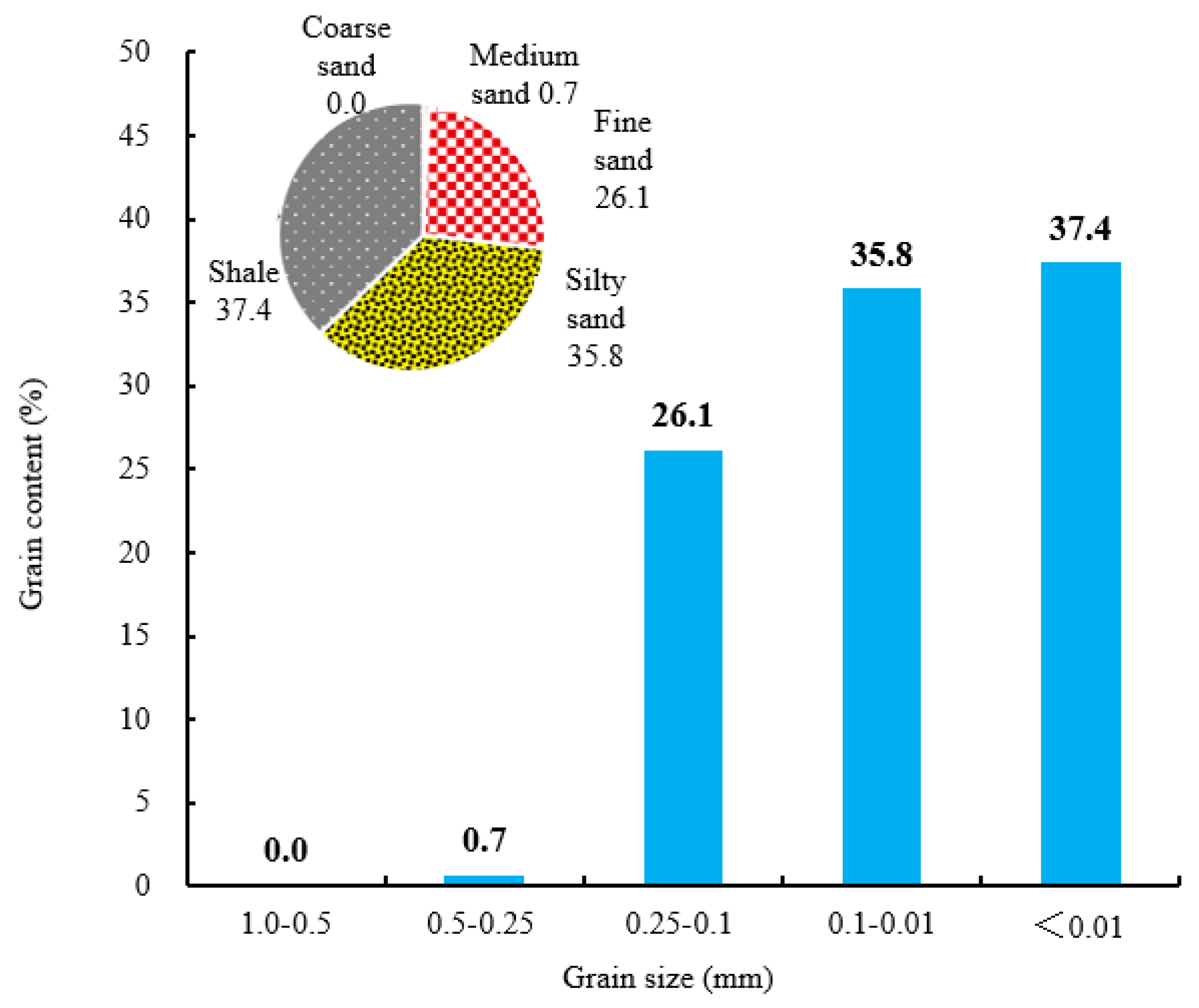
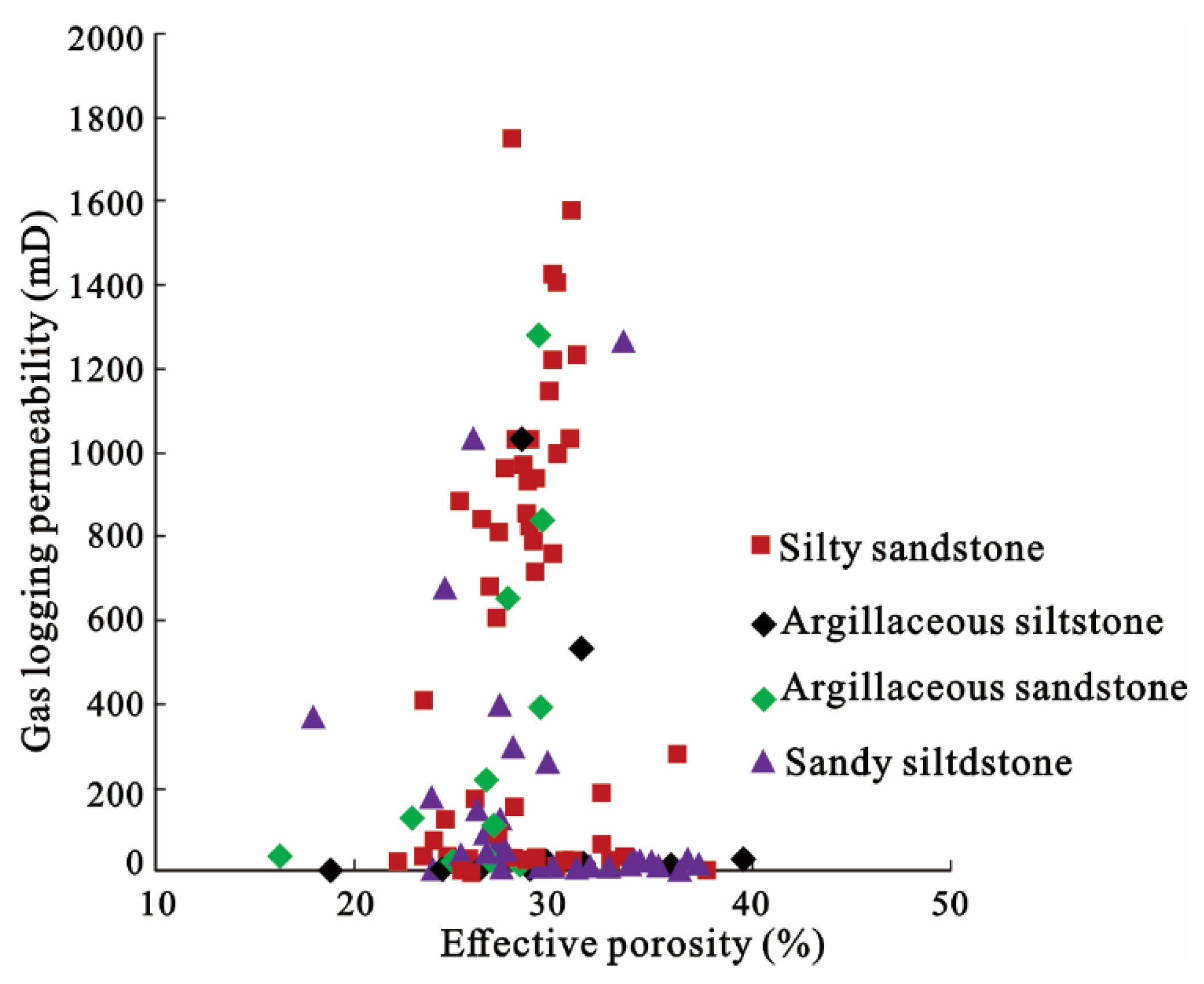
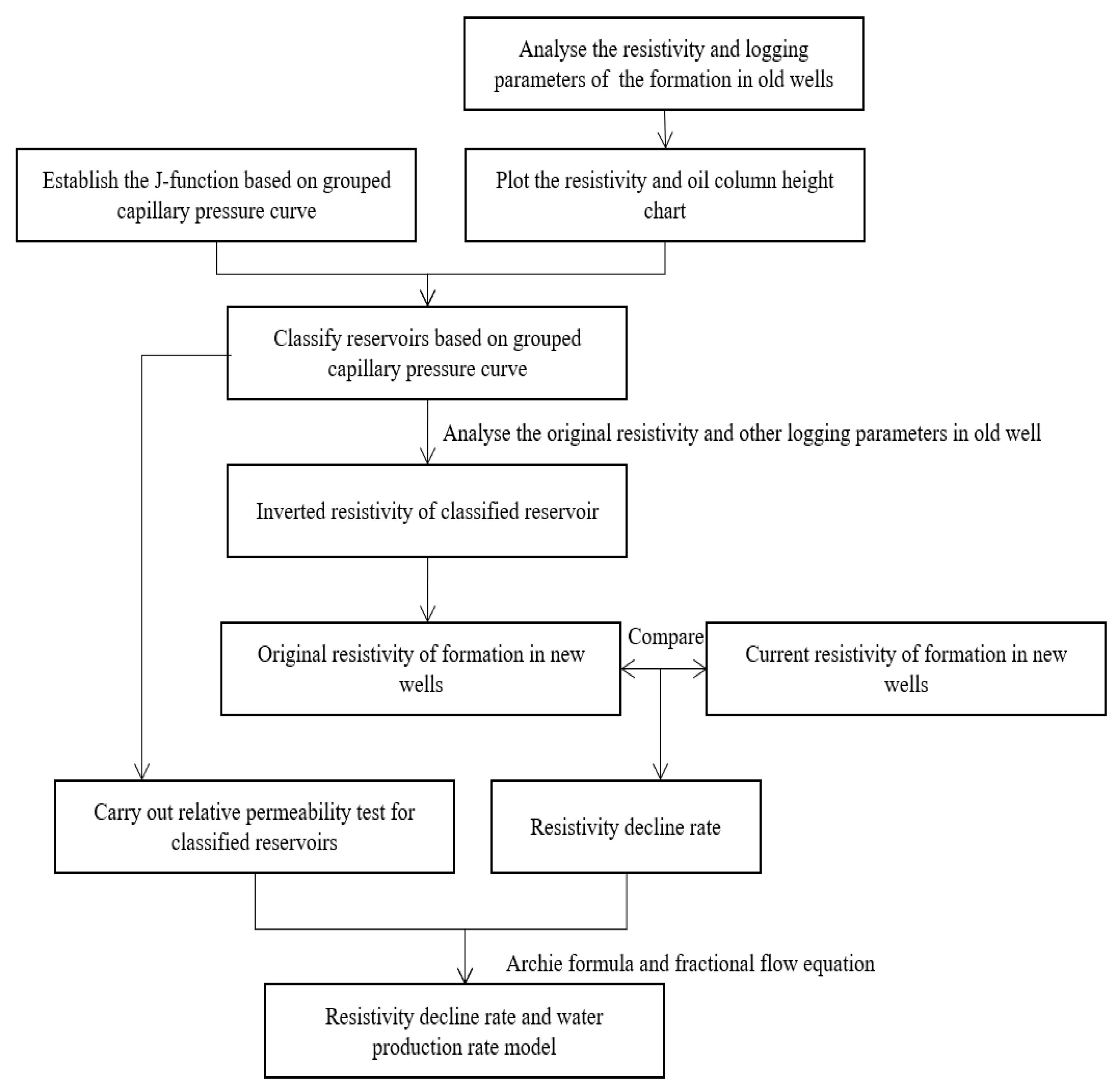
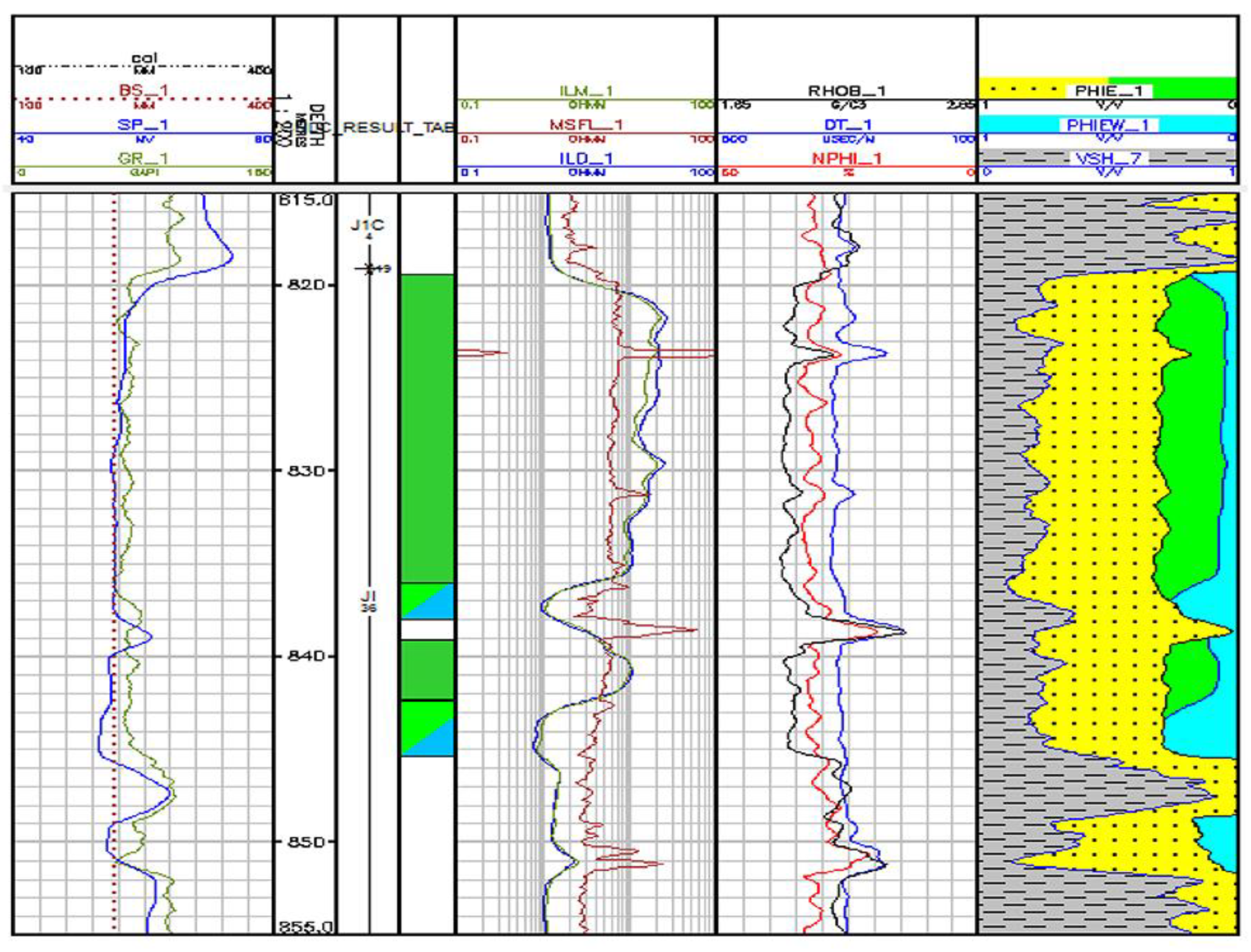
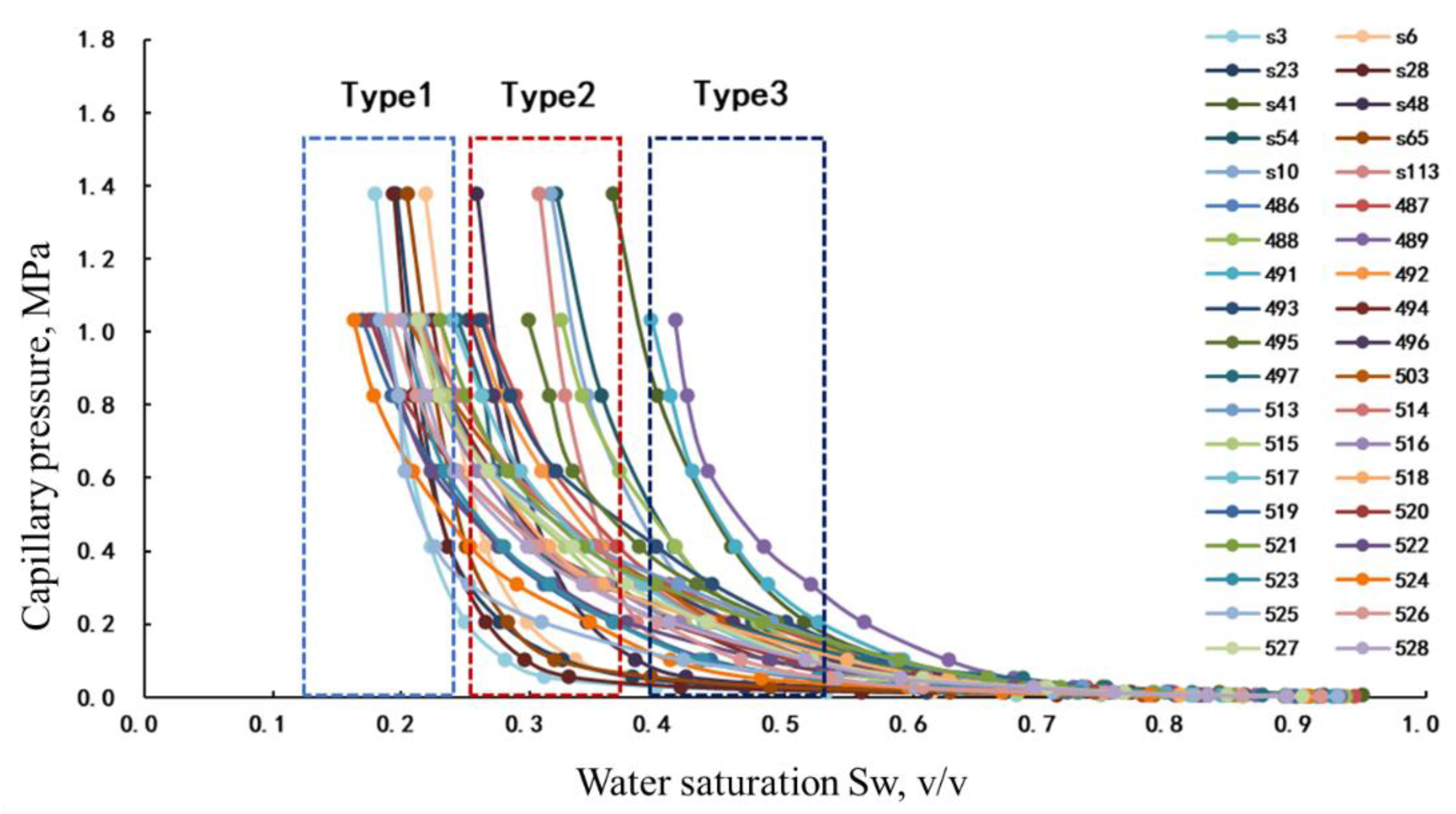

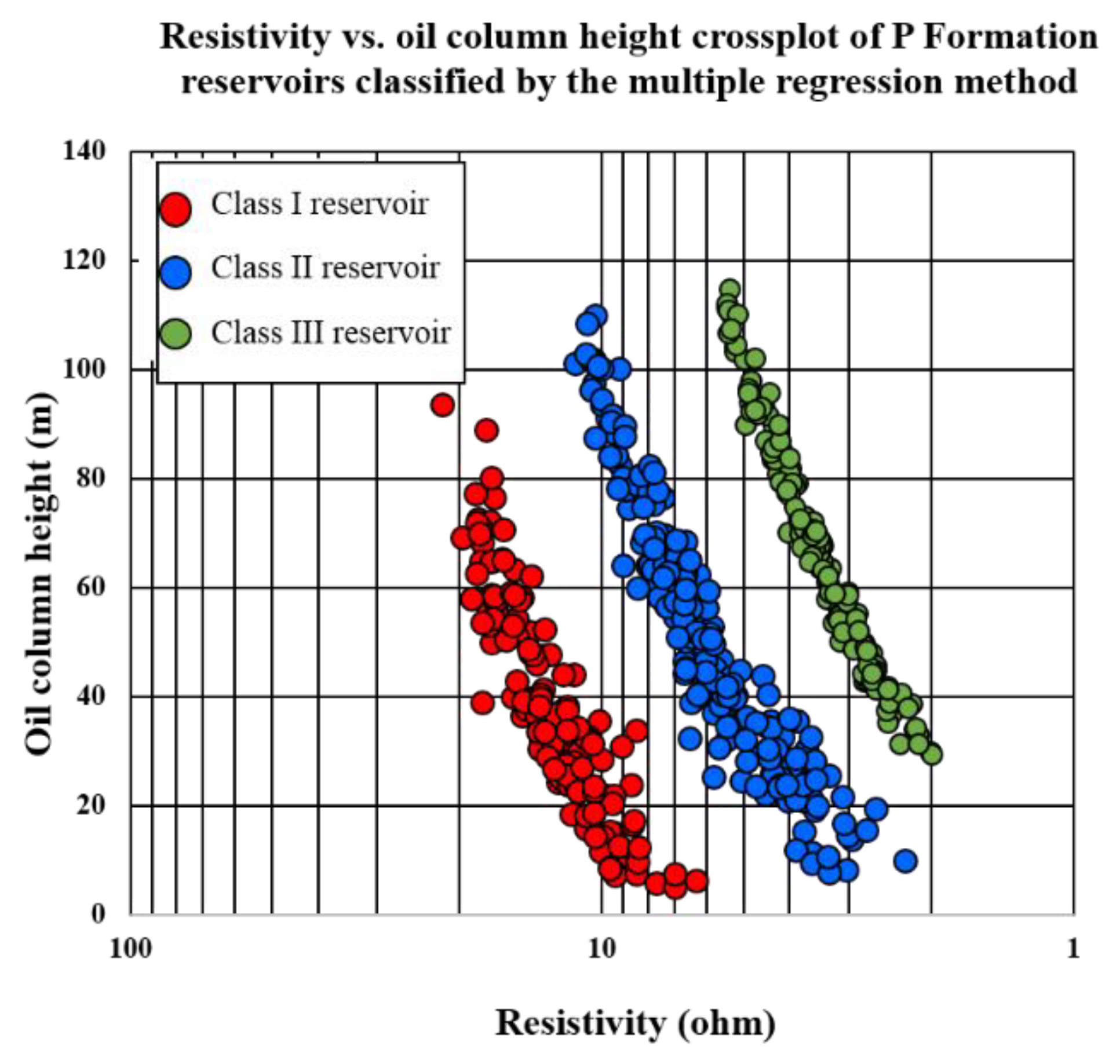
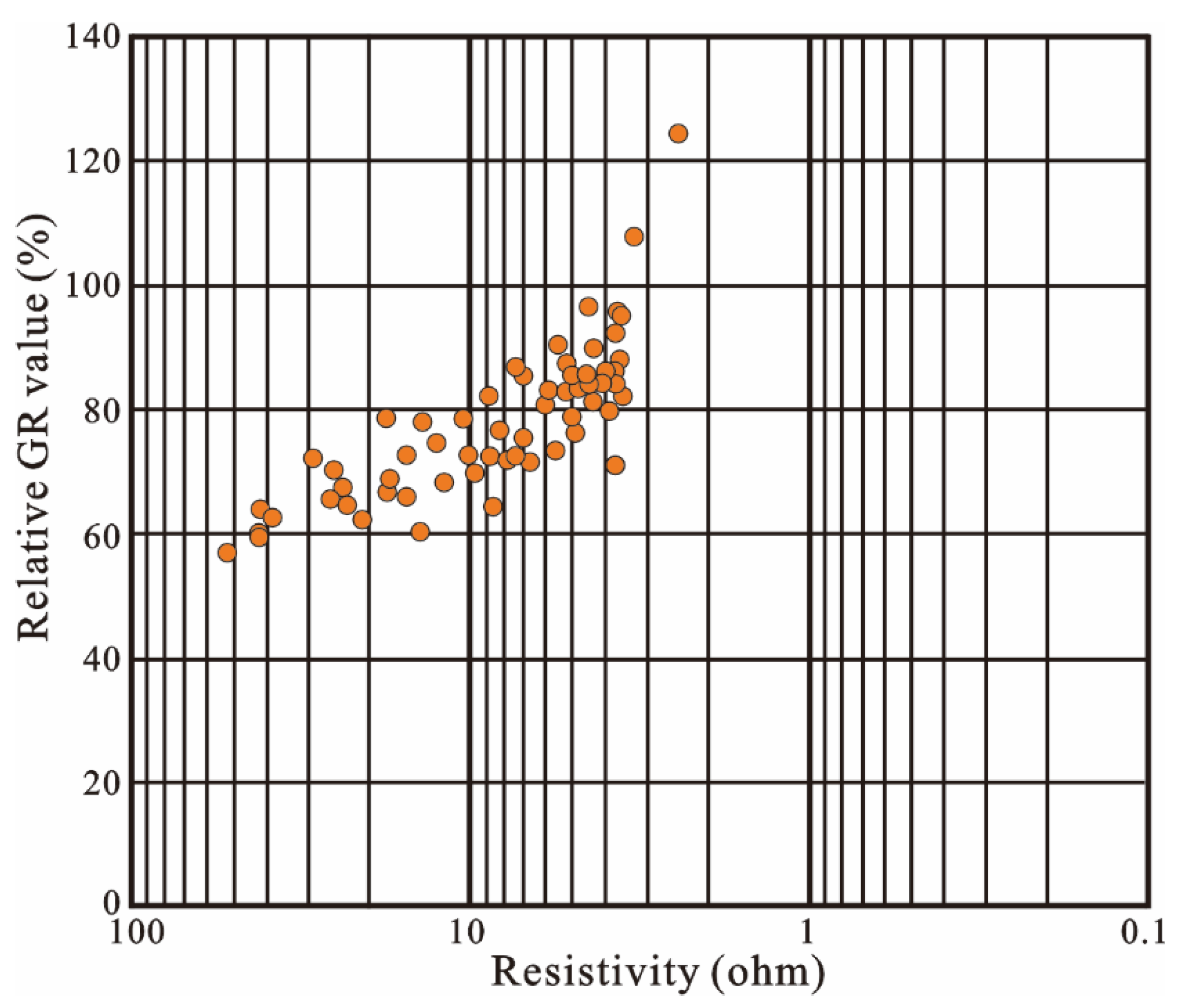


| Core No. | Core Length/cm | Core Diameter/cm | Porosity (Water)/% | Porosity (Gas)/% | Gas Logging Permeability/10−3 μm2 | RQI | Saturated Median Pressure/Mpa | Minimum Wet Phase Saturation (Irreducible Water Saturation)/% |
|---|---|---|---|---|---|---|---|---|
| 486 | 5.3 | 3.8 | 25.6 | 25.7 | 18.4 | 8.5 | 0.1 | 25.0 |
| 488 | 5.4 | 3.4 | 25.1 | 25.1 | 1.9 | 2.7 | 0.1 | 33.0 |
| 489 | 5.2 | 3.7 | 21.0 | 21.1 | 2.7 | 3.6 | 0.4 | 41.0 |
| 491 | 5.5 | 3.8 | 22.8 | 22.9 | 5.3 | 4.8 | 0.3 | 11.0 |
| 495 | 5.2 | 3.5 | 26.6 | 26.8 | 15.0 | 7.5 | 0.2 | 30.0 |
| 41 | 5.2 | 3.8 | 25.9 | 25.9 | 12.3 | 6.9 | 0.2 | 37.0 |
| 496 | 5.0 | 3.5 | 29.7 | 29.7 | 51.6 | 13.2 | 0.2 | 25.0 |
| 497 | 5.1 | 3.8 | 30.7 | 30.8 | 53.6 | 13.2 | 0.2 | 24.0 |
| 492 | 5.2 | 3.6 | 29.7 | 29.8 | 81.4 | 16.5 | 0.2 | 26.0 |
| 493 | 5.5 | 3.1 | 30.1 | 30.2 | 60.4 | 14.2 | 0.2 | 26.0 |
| 494 | 5.5 | 3.3 | 29.8 | 30.1 | 58.5 | 13.9 | 0.1 | 22.0 |
| 487 | 5.2 | 3.5 | 29.5 | 29.6 | 36.8 | 11.2 | 0.1 | 26.0 |
| 503 | 5.2 | 3.8 | 33.6 | 33.8 | 533.8 | 39.7 | 0.1 | 21.0 |
| 513 | 4.9 | 3.5 | 32.9 | 33.2 | 475.4 | 37.9 | 0.2 | 22.0 |
| 514 | 5.2 | 3.2 | 32.1 | 32.1 | 404.7 | 35.5 | 0.1 | 21.0 |
| 515 | 5.3 | 3.4 | 32.0 | 32.1 | 309.7 | 31.1 | 0.1 | 20.0 |
| 516 | 5.5 | 3.5 | 32.3 | 32.4 | 482.2 | 38.6 | 0.1 | 21.0 |
| 517 | 5.6 | 3.5 | 30.8 | 30.8 | 345.2 | 33.5 | 0.2 | 24.0 |
| 527 | 5.3 | 3.8 | 33.0 | 33.1 | 448.4 | 36.8 | 0.1 | 21.0 |
| 528 | 5.3 | 3.8 | 32.6 | 32.7 | 414.6 | 35.6 | 0.1 | 20.0 |
| 518 | 5.2 | 3.8 | 32.2 | 32.2 | 1020.0 | 56.3 | 0.2 | 21.0 |
| 519 | 5.2 | 3.8 | 34.1 | 34.2 | 845.4 | 49.7 | 0.1 | 17.0 |
| 520 | 5.4 | 3.7 | 30.6 | 30.7 | 1140.0 | 60.9 | 0.1 | 18.0 |
| 521 | 5.0 | 3.8 | 30.8 | 30.8 | 721.5 | 48.4 | 0.2 | 23.0 |
| 522 | 5.3 | 3.8 | 32.2 | 32.3 | 1120.0 | 58.9 | 0.1 | 18.0 |
| 523 | 5.2 | 3.7 | 30.9 | 31.0 | 758.5 | 49.5 | 0.1 | 21.0 |
| 524 | 5.1 | 3.5 | 32.6 | 32.7 | 1070.0 | 57.2 | 0.1 | 16.0 |
| 525 | 4.8 | 3.2 | 33.5 | 33.5 | 880.9 | 51.3 | 0.1 | 18.0 |
| 526 | 5.3 | 3.1 | 31.0 | 31.1 | 951.4 | 55.3 | 0.1 | 19.0 |
| 3 | 5.2 | 3.6 | 36.9 | 36.9 | 821.9 | 47.2 | 0.0 | 18.0 |
| 6 | 5.7 | 3.2 | 30.8 | 30.8 | 394.7 | 35.8 | 0.0 | 22.0 |
| 23 | 4.9 | 3.1 | 35.1 | 35.1 | 654.9 | 43.2 | 0.2 | 19.0 |
| 28 | 5.7 | 3.3 | 35.8 | 35.8 | 522.4 | 38.2 | 0.2 | 19.0 |
| Formation | >1 | 1.0–0.5 | 0.5–0.25 | 0.25–0.1 | 0.1–0.01 | <0.01 |
|---|---|---|---|---|---|---|
| Coarse sand | Medium sand | Fine sand | Silty sand | Mud | ||
| P | 0.00 | 0.01 | 0.66 | 26.13 | 35.81 | 37.38 |
| Well Name | Well Type | Start Depth (m) | End Depth (m) | GZ3 Average | Oil Column Height | GR Relative Value | Inverted Resistivity | Class of Reservoir | GR | VSH (V/V) | SW (V/V) | PERM |
|---|---|---|---|---|---|---|---|---|---|---|---|---|
| XX84 | Production well | 732.8 | 738.8 | 9.0 | 111.5 | 83.8 | 5.4 | III | 155.0 | 0.1 | 0.3 | 328.0 |
| XX57 | Production well | 742.1 | 744.6 | 7.6 | 104.4 | 81.3 | 5.2 | III | 130.0 | 0.1 | 0.4 | 444.5 |
| XX24 | Production well | 754.5 | 757.3 | 6.9 | 92.9 | 82.4 | 4.8 | III | 136.0 | 0.2 | 0.1 | 310.5 |
| XX67 | Production well | 740.9 | 745.8 | 6.8 | 103.3 | 80.0 | 5.2 | III | 124.0 | 0.2 | 0.3 | 160.3 |
| XX72 | Production well | 745.3 | 747.1 | 6.2 | 101.8 | 85.7 | 5.0 | III | 150.0 | 0.2 | 0.3 | 11.6 |
| XX63 | Production well | 744.3 | 749.1 | 19.5 | 101.2 | 73.8 | 11.4 | II | 104.0 | 0.1 | 0.2 | 283.9 |
| XX73 | Production well | 740.4 | 748.4 | 18.3 | 101.6 | 81.5 | 10.6 | II | 106.0 | 0.1 | 0.2 | 138.9 |
| XX46 | Water injection well | 745.7 | 751.4 | 15.6 | 97.5 | 80.0 | 10.4 | II | 124.0 | 0.2 | 0.2 | 301.9 |
| XX39 | Production well | 760.3 | 764.8 | 15.5 | 83.9 | 77.9 | 9.6 | II | 113.0 | 0.2 | 0.2 | 290.9 |
| XX15 | Production well | 763.9 | 767.7 | 14.6 | 82.4 | 80.6 | 9.1 | II | 141.0 | 0.2 | 0.2 | 167.5 |
| XX54 | Production well | 807.4 | 811.0 | 28.3 | 37.6 | 81.5 | 12.2 | I | 137.0 | 0.1 | 0.1 | 1537.5 |
| XX72 | Water injection well | 773.3 | 782.2 | 27.9 | 68.2 | 76.5 | 17.9 | I | 146.8 | 0.2 | 0.2 | 229.3 |
| XX21 | Production well | 812.6 | 814.5 | 27.1 | 36.4 | 70.3 | 14.8 | I | 116.0 | 0.1 | 0.2 | 206.8 |
| XX54 | Production well | 774.5 | 784.6 | 26.3 | 65.4 | 81.2 | 16.3 | I | 134.0 | 0.1 | 0.1 | 317.2 |
| XX76 | Production well | 747.7 | 758.2 | 24.6 | 88.9 | 90.0 | 17.6 | I | 162.0 | 0.1 | 0.1 | 482.5 |
| Class of Reservoirs | Porosity (%) | Permeability (mD) | Relative GR Value (%) | Shale Content (%) | Lithology |
|---|---|---|---|---|---|
| I | >28 | >600 | <76 | <21 | Mainly sandstone and fine sandstone |
| II | 22~28 | 30~600 | 76~85 | 21~32 | Mainly siltstone |
| III | <22 | <30 | >85 | >32 | Mainly argillaceous sandstone |
| Class of Reservoirs | Proportion | Highly Water-Flooded | Moderately Water-Flooded | Weakly Water-Flooded | Non-Water-Flooded |
|---|---|---|---|---|---|
| I | 54% | 60% | 23% | 7% | 9% |
| II | 39% | 25% | 31% | 9% | 33% |
| III | 7% | 2% | 19% | 15% | 63% |
| Well | Depth_T | Depth_B | Class of Reservoir | Regression Resistivity | Calculated Water Production Rate, % | Water-Flooding Level | Well Production Data |
|---|---|---|---|---|---|---|---|
| XX28 | 790.9 | 793.2 | II | 7.74 | 32.2 | Moderately water-flooded | fw = 62.9% |
| XX28 | 794.7 | 801.2 | II | 7.02 | 85.0 | Highly water-flooded | |
| XX36 | 800.4 | 804.5 | I | 17.94 | 96.9 | Highly water-flooded | fw = 94.1% |
| XX36 | 804.5 | 806.6 | I | 18.07 | 99.5 | Highly water-flooded | |
| XX36 | 811.0 | 812.7 | I | 17.21 | 92.5 | Highly water-flooded | |
| XX36 | 810.7 | 814.0 | II | 12.31 | 99.5 | Highly water-flooded | |
| XX46 | 816.3 | 817.6 | II | 6.08 | 12.2 | Weakly water-flooded | fw = 57.6% |
| XX46 | 818.9 | 824.4 | I | 9.15 | 64.0 | Moderately water-flooded | |
| XX46 | 826.0 | 826.6 | II | 9.29 | 75.5 | Moderately water-flooded | |
| XX46 | 829.6 | 838.9 | I | 12.83 | 99.2 | Highly water-flooded | |
| XX46 | 840.5 | 841.0 | II | 4.42 | 67.8 | Moderately water-flooded | |
| XX46 | 842.0 | 842.8 | III | 2.50 | −55.3 | Non-water-flooded | |
| XX37 | 787.2 | 790.7 | II | 8.28 | 89.05 | Highly water-flooded | fw = 79.6% |
| XX37 | 791.9 | 794.4 | I | 8.05 | 73.59 | Moderately water-flooded |
Publisher’s Note: MDPI stays neutral with regard to jurisdictional claims in published maps and institutional affiliations. |
© 2022 by the authors. Licensee MDPI, Basel, Switzerland. This article is an open access article distributed under the terms and conditions of the Creative Commons Attribution (CC BY) license (https://creativecommons.org/licenses/by/4.0/).
Share and Cite
Li, X.; Wang, J.; Zhao, D.; Ni, J.; Lin, Y.; Zhang, A.; Zhao, L.; Liu, Y. Quantitative Evaluation of Water-Flooded Zone in a Sandstone Reservoir with Complex Porosity–Permeability Relationship Based on J-Function Classification: A Case Study of Kalamkas Oilfield. Energies 2022, 15, 7037. https://doi.org/10.3390/en15197037
Li X, Wang J, Zhao D, Ni J, Lin Y, Zhang A, Zhao L, Liu Y. Quantitative Evaluation of Water-Flooded Zone in a Sandstone Reservoir with Complex Porosity–Permeability Relationship Based on J-Function Classification: A Case Study of Kalamkas Oilfield. Energies. 2022; 15(19):7037. https://doi.org/10.3390/en15197037
Chicago/Turabian StyleLi, Xuanran, Jingcai Wang, Dingding Zhao, Jun Ni, Yaping Lin, Angang Zhang, Lun Zhao, and Yuming Liu. 2022. "Quantitative Evaluation of Water-Flooded Zone in a Sandstone Reservoir with Complex Porosity–Permeability Relationship Based on J-Function Classification: A Case Study of Kalamkas Oilfield" Energies 15, no. 19: 7037. https://doi.org/10.3390/en15197037
APA StyleLi, X., Wang, J., Zhao, D., Ni, J., Lin, Y., Zhang, A., Zhao, L., & Liu, Y. (2022). Quantitative Evaluation of Water-Flooded Zone in a Sandstone Reservoir with Complex Porosity–Permeability Relationship Based on J-Function Classification: A Case Study of Kalamkas Oilfield. Energies, 15(19), 7037. https://doi.org/10.3390/en15197037






